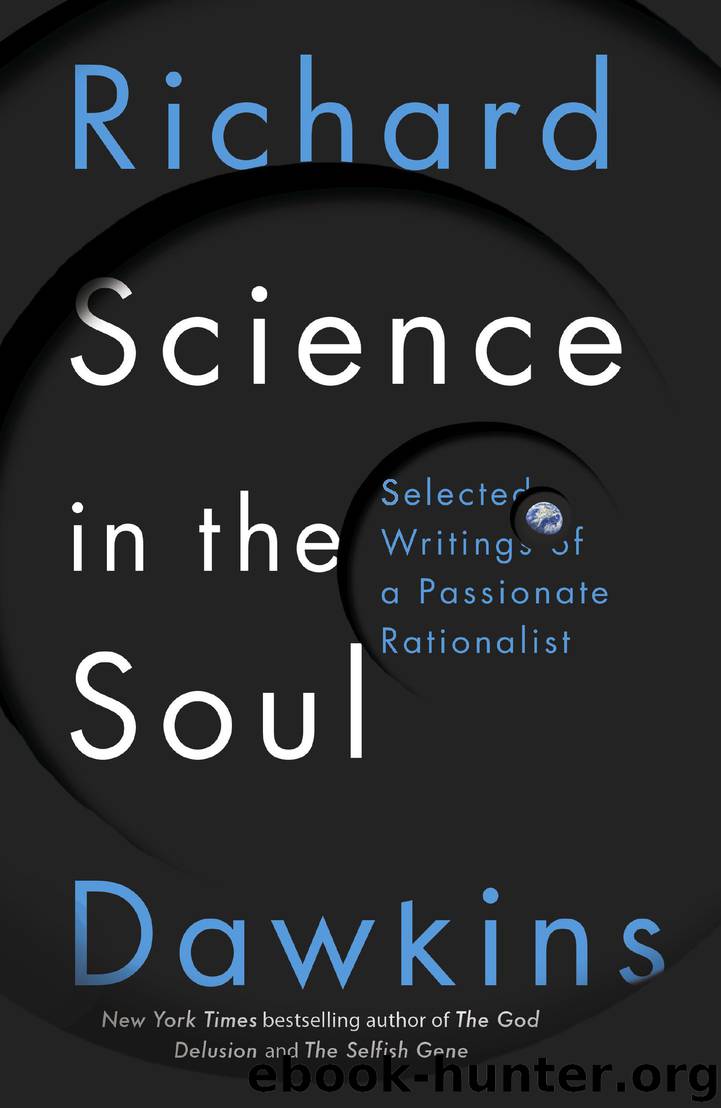Science in the Soul by Richard Dawkins

Author:Richard Dawkins
Language: eng
Format: epub
Publisher: Random House Publishing Group
Published: 2017-08-08T04:00:00+00:00
Given that chance is ruled out for sufficient levels of improbability, we know of only two processes that can generate specified improbability. They are intelligent design and natural selection, and only the latter is capable of serving as an ultimate explanation. It generates specified improbability from a starting point of great simplicity. Intelligent design can’t do that, because the designer must itself be an entity at an extremely high level of specified improbability. Whereas the specification of the Boeing 747 is that it must be able to fly, the specification of the ‘intelligent designer’ is that it must be able to design. And intelligent design cannot be the ultimate explanation for anything, for it begs the question of its own origin.
From the lowlands of primeval simplicity, natural selection gradually and steadily ramps its way up the gentle slopes of Mount Improbable until, after sufficient geological time, the end product of evolution is an object such as an eye or a heart – something of such an elevated level of specified improbability that no sane person could attribute it to random chance. The single most unfortunate misunderstanding of Darwinism is that it is a theory of chance; the misunderstanding presumably stems from the fact that mutation is random.*8 But natural selection is anything but random. To escape from chance is the primary accomplishment that any theory of life must aspire to. Obviously, if natural selection were a theory of random chance, it could not be right. Darwinian natural selection is the non-random survival of randomly varying coded instructions for building bodies.
Some engineers even use explicitly Darwinian methods in order to optimize systems. They escalate performance from poor beginnings up a ramp of improvement to something approaching an optimum. Something like this process may be true of all engineers, even if they don’t think of it as explicitly Darwinian. The engineer’s wastepaper basket holds the ‘mutant’ designs he discarded before putting them to the test. Some designs don’t even make it onto paper but are discarded in the engineer’s head. I have no need to pursue the question of whether Darwinian natural selection is a good or helpful model for what goes on in the brain of a creative engineer or artist; constructive creative work – by engineers or artists, or indeed anybody – may or may not plausibly represent a form of Darwinism. The fundamental point remains that all specified complexity must ultimately rise from simplicity by some kind of escalatory process.
If we ever discover evidence that some aspect of life on Earth is so complex that it must have been intelligently designed, scientists will face with equanimity – and doubtless some excitement – the possibility that it was designed by an extraterrestrial intelligence. The molecular biologist Francis Crick, together with his colleague Leslie Orgel, made such a suggestion (I suspect, tongue in cheek) in proposing the theory of directed panspermia. According to Orgel and Crick’s idea, extraterrestrial designers deliberately seeded Earth with bacterial life.*9 But the important point is that
Download
This site does not store any files on its server. We only index and link to content provided by other sites. Please contact the content providers to delete copyright contents if any and email us, we'll remove relevant links or contents immediately.
Sapiens: A Brief History of Humankind by Yuval Noah Harari(14314)
Sapiens by Yuval Noah Harari(5321)
Pale Blue Dot by Carl Sagan(4950)
Homo Deus: A Brief History of Tomorrow by Yuval Noah Harari(4870)
Livewired by David Eagleman(3729)
Origin Story: A Big History of Everything by David Christian(3665)
Brief Answers to the Big Questions by Stephen Hawking(3392)
Inferior by Angela Saini(3293)
Origin Story by David Christian(3170)
Signature in the Cell: DNA and the Evidence for Intelligent Design by Stephen C. Meyer(3098)
The Gene: An Intimate History by Siddhartha Mukherjee(3074)
The Evolution of Beauty by Richard O. Prum(2962)
Aliens by Jim Al-Khalili(2802)
How The Mind Works by Steven Pinker(2770)
A Short History of Nearly Everything by Bryson Bill(2659)
Sex at Dawn: The Prehistoric Origins of Modern Sexuality by Ryan Christopher(2500)
From Bacteria to Bach and Back by Daniel C. Dennett(2462)
Endless Forms Most Beautiful by Sean B. Carroll(2442)
Who We Are and How We Got Here by David Reich(2416)
